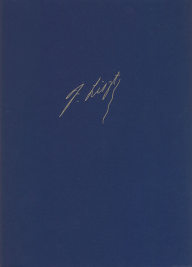Liszt Ferenc: Klavierkonzert in Es-Dur, Op. posth. (Arbeitsmanuskript)
Franz Liszt, Neue Ausgabe sämtlicher Werke, Serie VII, Bd. 2
Partitur
Liszt composed a mature concerto from heterogeneous elements of three juvenile piano pieces (Huit variations op. 1, Allegro di bravura, op. 4[a], and Rondo di bravura, op. 4[b]). The entire concerto can also be analysed as a single sonata form movement, with an exposition, development, and recapitulation in two keys (E minor and G-flat major), sections which also correspond to each movement. This dual construction principle, known as the „two-functional form” or „two-dimensional sonata form”, is what Liszt adopted, essentially already in 1835╩36 in De profundis, and in 1839 in the three concertos. These works can therefore be considered as the first mature realization of this Lisztian concept.
The first public performance of the posthumous piano concerto was on 3 May 1990, by Janina Fialkowska and the Chicago Symphony Orchestra, conducted by Kenneth Jean. At the European premiere, on 5 May 1990, the soloist was Steven Mayer, and the Residentie Orchestra of The Hague was conducted by Jacek Kaspszyk.
This volume comes complete with a detailed preface on the genesis and significance of the posthumous Concerto in English, German, and Hungarian, several manuscript facsimiles, and critical report in English.
 English
English Español
Español Français
Français Magyar
Magyar Polski
Polski Română
Română Slovenský
Slovenský Slovenščina
Slovenščina 中文
中文





































































